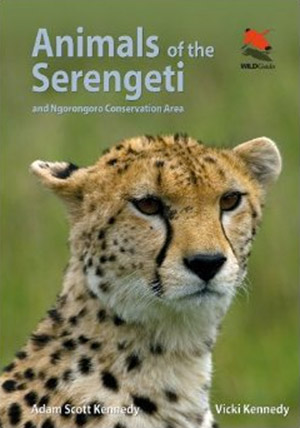Animals of the Serengeti: And Ngorongoro Conservation Area by Adam Scott Kennedy and Vicki Kennedy is an easy-to-use guidebook that is also very readable. The region covered by the book is the Greater Serengeti area bounded in the west by Lake Victoria and the east by Lake Manyara in Tanzania, and in the north by southern Kenya.
Animals of the Serengeti: And Ngorongoro Conservation Area is designed for the traveller. The book is lightweight with each page filled with pictures and brief scientific explanations for each animal.
Still, what I find most intriguing about the book, which I also think you will also enjoy, is the incorporation of short first-hand stories told by local guides. These are the individuals with years of expertise in supporting conservation in the region. They also form the cultural backbone of local community efforts to conserve life within the boundaries of the local ecosystems. These guides tell wonderful anecdotal—and sometimes hilarious—stories about the local fauna.
 |
Following up on the publication of their Animals of the Masai Mara and Birds of the Masai Mara, and published in conjunction with their Birds of the Serengeti: And Ngorongoro Conservation Area, Animals of the Serengeti: And Ngorongoro Conservation Area is a great read. Reading the guidebook, you get a real sense of the how the coauthors have built their life’s passion into a full-time career that positively impacts conservation. The work they do and the guidebooks they write are inspiring.
How to order:
Paperback: Animals of the Serengeti: And Ngorongoro Conservation Area
Publisher: Princeton University Press
Authors: Adam Scott Kennedy and Vicki Kennedy
ISBN: 9780691159089
Gabriel Thoumi is a frequent contributor to Mongabay.com. He is an Affiliated Researcher at the Conservation Management Institute at Virginia Tech.
Related articles
Predator appreciation: how saving lions, tigers, and polar bears could rescue ourselves

(01/29/2014) In the new book, In Predatory Light: Lions and Tigers and Polar Bears, authors Elizabeth Marshall Thomas, Sy Montgomery, and John Houston, and photographers Cyril Christo and Marie Wilkinson share with us an impassioned and detailed appeal to appreciate three of the world’s biggest predators: lions, tigers, and polar bears. Through lengthy discussions, combining themes from scientific conservation to local community folklore, In Predatory Light takes us step by step deeper into the wild world of these awe-inspiring carnivores and their varied plight as they facedown extinction.
Primates of the World: An Illustrated Guide – book review
(09/18/2013) Primates of the World: An Illustrated Guide is stunning. There is simply no better way I can think of to gain an appreciation of the primate family than to peruse Primates of the World: An Illustrated Guide.
On Gaia: A Critical Investigation of the Relationship between Life and Earth – book review
(08/19/2013) In the new book, On Gaia: A Critical Investigation of the Relationship between Life and Earth, Dr. Toby Tyrrell analyzes 40-years of data for and against the Gaia hypothesis. Dr. James Lovelock, along Dr. Lynn Margulis, co-developed the Gaia Hypothesis in the 1970s. The Gaia Hypothesis suggests that life itself, in unison across species and through complex interactions, controls the inorganic structures and forms of the Earth.
Novel Ecosystems: Intervening in the New Ecological World Order – book review
(08/12/2013) Novel Ecosystems: Intervening in the New Ecological World Order is a recent textbook published by Wiley-Blackwell edited by Richard J. Hobbs, Eric S. Higgs, and Carol M. Hall that describes the emerging issues around novel ecosystems. Novel ecosystems are rapidly developing globally in response to land conversion, climate change, invasive species, and other ecological crises. Novel ecosystems are anthropogenically modified ecosystems that have developed during the Anthropocene.